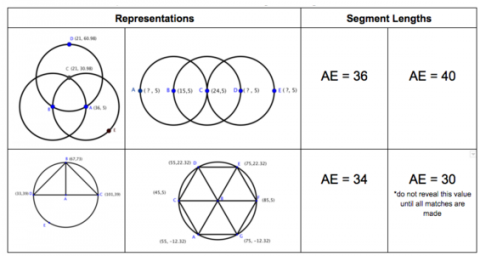Evidence of Understanding
- describe the qualities that make two line segments congruent or incongruent
- given any two objects (non-geometric), describe what is the same and different about them
- Example: a pen and a pencil
- identify and justify why two objects are the same or different
- distinguish “exactly the same” from “alike”
- discuss the difference between points, lines, rays, and line segments in terms of congruence
- demonstrate how a straight line segment can be drawn joining any two points (Euclid’s first postulate)
- demonstrate how any straight line segment can be extended indefinitely in a straight line (Euclid’s second postulate)
- justify which qualities are significant or insignificant for determining if two segments in geometry are congruent
- Example: length measure vs.color of the segment, thickness, etc.
- given any two objects (non-geometric), describe what is the same and different about them
- define radius as a relationship between a circle’s center and points on the circle
- use the compass points to justify that all radii are equidistant and congruent
- explain how given any straight lines segment, a circle can be drawn having the segment as radius and one endpoint as center (Euclid’s third postulate).
- explain how given any straight lines segment, a circle can be drawn having the segment as radius and one endpoint as center (Euclid’s third postulate).
- use the compass points to justify that all radii are equidistant and congruent
- construct congruent segments and justify their congruence
- given a line segment, create a congruent segment, and explain why they are congruent
- use notation to signify congruence
- describe how a compass can be used to construct congruent segments
- justify that two segments take up the same distance in space
- consider and describe implications of human error
- bisect a line segment and justify congruence of both parts
- explain that the midpoint bisects a line segment
- use segment addition to explain that each part is half the measure of the whole
- compare methods for determining congruence and describe advantages of each type
- Examples: paper folding, placing the segment (vertical and horizontal only) on the coordinate grid, using patty paper or online software to translate, rotate, or reflect image, etc.
- given a line segment, create a congruent segment, and explain why they are congruent
Develop conceptual understanding:
congruent, incongruent, point, line, ray, line segment, postulate, length measure, circle, radius, equidistant, distance, bisect, midpoint, segment additionSupporting terms to communicate:
compass, straightedge, construction, collinear, coplanar, plane, space, partition, centerpoint, arc, coordinate grid







